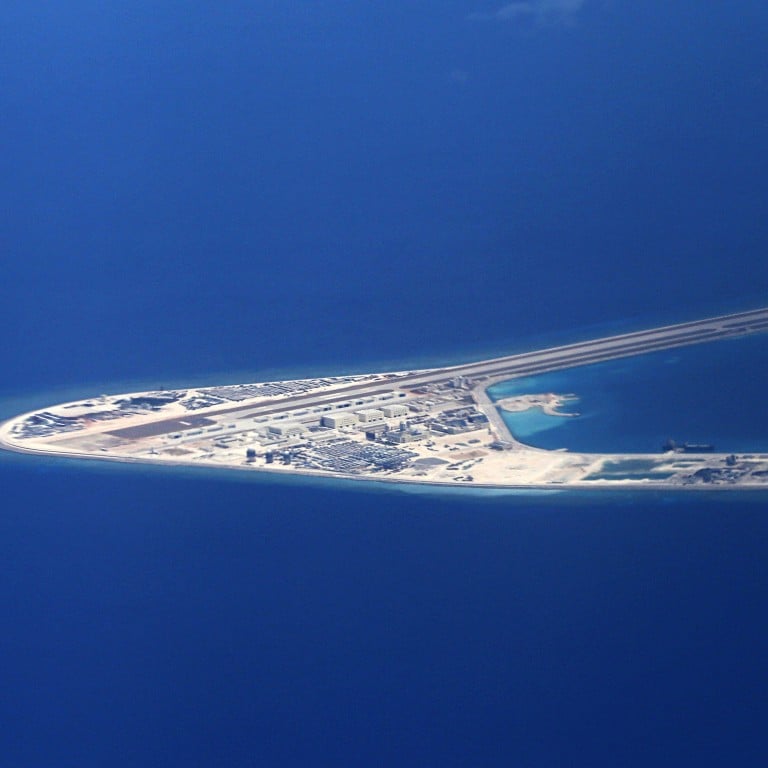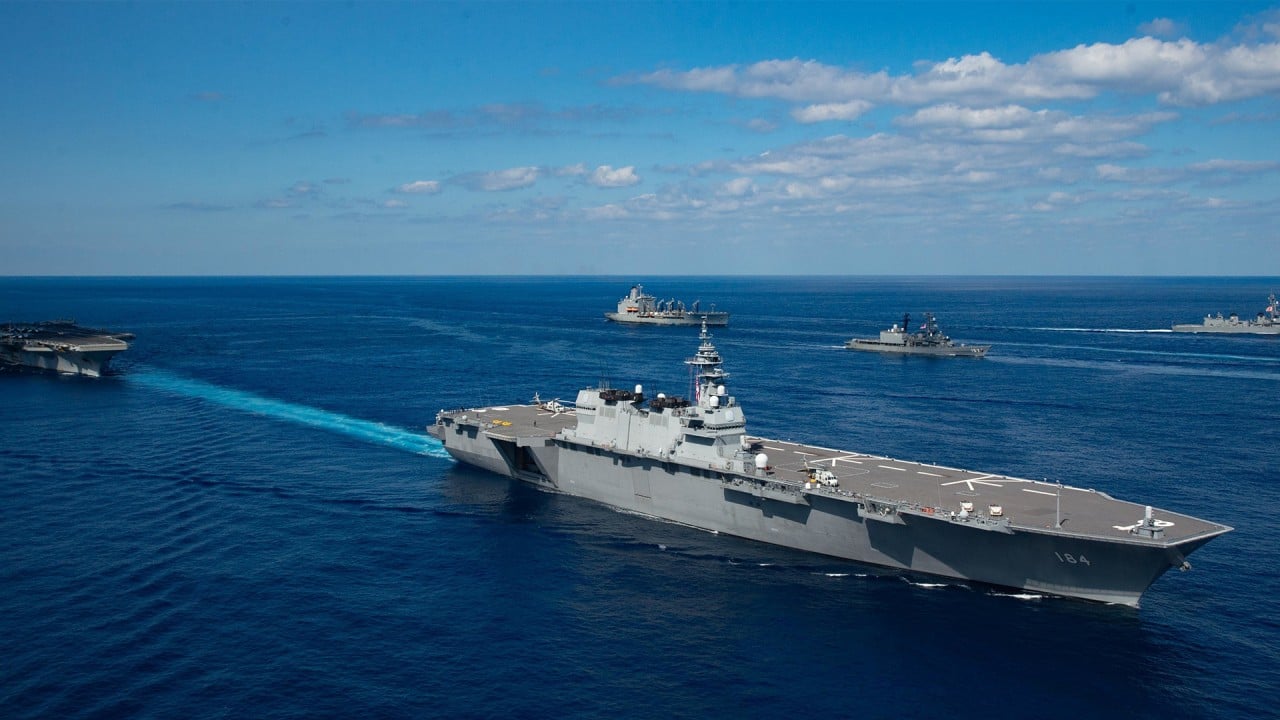
South China Sea: how a Spratlys radar system could give the PLA an information edge
- Beijing’s crisis management plans to deal with rising US-China tensions include its artificial structures in the disputed area
- Communications network aims for information superiority in the region but remote location makes them vulnerable
A report in Chinese military magazine Naval and Merchant Ships, said the US had tried to create a “grey zone” by forming a mini “Nato” in the Pacific to counter China, in a C-shaped arc linking India, Singapore, Taiwan, Japan and South Korea.
“Beijing should take countermeasures to cope with the US ‘grey zone tactics’ and let the US realise China is neither a passive receiver nor regional guest in Washington’s Indo-Pacific strategy, but a key player and master in the region,” according to the analysis in the December edition of the magazine, run by the Chinese navy’s main contractor China State Shipbuilding Corporation.
The article said superiority in battlefield information – provided by the artificial islands’ uninterrupted communications network connecting the Beijing military command with frontline outposts – could be the most efficient way to beat the US in a conflict in the disputed waterway.
South China Sea: the dispute that could start a military conflict
China built the seven permanent islands between 2013 and 2017 and claims they are home to naval garrisons, coastguard personnel, maritime inspectors, meteorological observation stations and other scientific research centres, as well as rest stops for Chinese fishermen.
Michael Dahm, a senior researcher at the Johns Hopkins University Applied Physics Laboratory in the US, said in August that the main purpose of the Chinese outposts was to facilitate information superiority over the US in the region, to counter American military advantage.
Writing in the online South China Sea Military Capabilities series, Dahm said the artificial islands were equipped with substantial C4ISR capabilities and counter-C4ISR capabilities – a US defence acronym for command, control, communications, computers used in intelligence, surveillance and reconnaissance (ISR).
Collin Koh, a research fellow at the maritime security programme at Nanyang Technological University in Singapore, said the role of the Spratlys outposts would be as significant multipliers for the PLA in times of both peace and possible conflict.
“In times of conflict, these outposts serve as ISR targeting nodes that help extend the PLA’s projection of kinetic military power further afield, beyond the South China Sea – most pertinently into the open maritime domain of the western Pacific Ocean,” he said.

01:30
More footage emerges from 2018 near collision of US and China warships in South China Sea
Koh said the islands’ ISR facilities would also play an essential role in countering US military intervention in a possible war between the PLA and Taiwanese military.
“The PLA will tap these outposts to forestall or counter American military intervention from that direction, or to facilitate its own offensive operations to outflank Taiwan from the south, with the Bashi Channel being especially critical in this regard,” he added.
China military: how Beijing is pushing forward its plan for a powerful, modern armed forces
Dahm, who is also a retired US Navy intelligence officer, said the KJ-500 early warning aircraft and some unmanned aerial vehicles stationed on the island reefs could be turned into airborne layer stations for contingency communications in case the long-haul PLA systems were damaged – one of the countermeasures to keep communication open between Hainan, the mainland and the artificial islands in non-peace time.
“In the information age, the Chinese People’s Liberation Army believes that success in combat will be realised by winning a struggle for information superiority in the operational battlespace,” Dahm wrote.
New US Indo-Pacific fleet ‘would be akin to grabbing China by the throat’
The PLA has built 27 large domes on the island-reefs to house radar providing air and surface surveillance across the frequency spectrum. Seven are deployed on the Fiery Cross, Subi and Mischief reefs, while undersea fibre-optic cables and low-earth orbit satellite systems form an uninterrupted communication network connecting the islands with the mainland.
The Naval and Merchant Ships article said the PLA’s ISR networks on the island reefs were capable of interrupting the US military communications system.
Zhou Chenming, a Beijing-based military expert specialising in communications, said the PLA’s ISR capabilities could cover the whole region, including military activity at the US Palawan airbase in the Philippines, about 350km (217 miles) from Mischief Reef.
Zhou and the military magazine article each said the reef outposts could be seen as an integrated South China Sea system-of-systems, but they were also vulnerable to a hard attack, with their remote location and lack of survivable systems.
The article warned that China should be on “high alert” after the US Department of State said Beijing had no legal grounds to unilaterally impose its will on the region and no lawful territorial or maritime claim to Mischief Reef – the largest artificial island in the Spratlys.
Zhou said China had turned the artificial islands into the country’s most advanced and comprehensive ISR platforms, and the US military would “pay a huge cost” if it decided to blow them up.
The Naval and Merchant Ships article said the US could deploy aircraft carrier strike groups, strategic bombers or even nuclear submarines with Tomahawk missiles to destroy the whole island network, but the consequences would be serious.
“In retaliation, China could attack US military bases in eastern and western Asia. The island reefs are not only China’s outposts, but an attractive ‘bait’ to trap rivals,” it said.

02:14
Japan-US hold joint military drills including cyberwarfare training as concerns about China grow
Antony Wong Tong, a Macau-based military expert, said the article was probably referring to the Diego Garcia naval and airbase in the Indian Ocean and the naval base at Guam in the Pacific.
“The Diego Garcia and Guam bases are two natural unsinkable aircraft carriers built by the US in the Indo-Pacific region … to some extent, China’s artificial islands could be seen as their copycats,” he said, adding that it would be predictable if war broke out for the opposing sides to pick peer-to-peer targets.
A Beijing-based military insider said the Chinese leadership understood that a “life-and-death fight” would occur if both sides refused to give way on the South China Sea issue.
US military using private spy planes to keep tabs on China: think tank
The PLA had proactively projected its “goodwill” to the Pentagon, he said, to prevent an irreversible tragedy, in response to increased close-in surveillance operations by US spy jets – and even strategic bombers – along the Chinese southeastern coast.
In the first six months of 2020, the US carried out 3,000 sorties by military aircraft and hundreds of naval voyages in the South China Sea, according to Naval and Merchant Ships.

